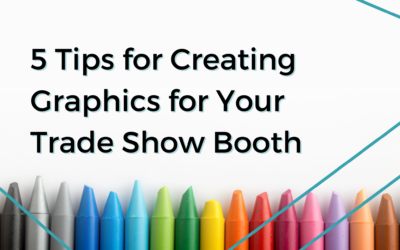1. Strategic Layout and Flow
One of the first steps in optimizing a small trade show booth is to plan the layout. Start by considering the flow of traffic and strategically positioning key elements. Ensure that your booth is easy to navigate, guiding visitors through a logical sequence that highlights your products or services. Also, it needs to be clear what you do with a 5 second glance.
2. Engaging Graphics and Branding
Graphics play a crucial role in attracting attention to your booth, especially in a crowded trade show environment. Opt for eye-catching, high-quality visuals that reflect your brand identity. Use concise messaging to convey why you matter to your target market.
3. Utilize Vertical Space
When floor space is limited, look up! Vertical displays and elements maximize space but also draw the eyes upward, creating a visually dynamic booth. Skinny shelves can provide a place for product display. I will often do levels on my tables as well. Boxes covered with a tablecloth or wooden crates give you an elevated space to place signage and products.
4. Keep Furniture and Displays to a Minimum
You want to make laser focus your message in a smaller trade show booth. A 10 x 10 booth does not have the room for a “meeting space”. I honestly often get rid of the chairs in a 10 x 10 space. (Read more about that here.) Your booth should not look like a convenience store (unless that is your business). You want people to know what you do and how you can help them at a glance.
I did have one small booth where I went against this. My client served a ton of different industries but they all had something to do with manufacturing – and we were headed to a manufacturing show. So, we reached out to all of the customers for the products that they manufactured and showcased them and all the people that my client could help.
People would stop and ask what the client did, and they were able to explain how they helped manufacturers. It was a great booth.
This is all to say that my “rules” are more guidelines and if you have a reason to break them, go for it.
5. Interactive Experiences
Incorporate touchscreens or product demonstrations to create a hands-on and immersive environment. Interactive displays not only capture attention but also encourage longer stays at your booth, allowing you to make a more lasting impact on potential customers.
You can do interactive displays in a 10 x 10 and a 10 x 20 space, you just have to think about compact displays. Can you take your product and make miniatures that come apart and show how they are built? Can you have a digital twin of you products that allow people to peer insides, rotate, and manipulate it on a touch screen?
Opt for compact and sleek technology setups that don’t take up much space. This allows you to show digital content, collect leads, and provide information without sacrificing valuable floor space.
6. Effective Signage and Messaging
This was said above but I do really want to drive this home. Craft clear and concise messaging that states what you do and how you can help people. You should have all text above the 4 ft line of your back drop. Your text should be readable from 15 feet back, and should think of it like an old school tweet – you only have 120 characters.
Clear messaging ensures that even in a small space, your brand message is communicated effectively and memorably.
In conclusion, small trade show booths can indeed make a big impact with thoughtful planning and creativity. Remember, it’s not about the size of the space, but how you use it to effectively showcase your brand and connect with your target audience. Here are some tips on Competing with the big Booths.
The 8 Major Dates You Need to Know for Your Trade Shows
Tradeshow are very deadline focused. There can be dozens of dates that you need to keep track of to ensure you are following the rules and getting the best discounts. These deadlines can make or break your show. Lets go through the major ones
5 Tips for Creating Graphics for Your Trade Show Booth
Among the things that contribute to a successful trade show exhibit, graphics play a crucial role in attracting attention, conveying messages effectively, and leaving a lasting impression. Here are 5 tips for utilizing graphics in your trade show booth to maximize engagement and hit your goals.
Budget-Friendly Trade Show Booth Design Hacks
Participation in trade shows can often come with a hefty price tag, especially when it comes to designing and building an attention-grabbing booth. Fortunately, with a bit of creativity and planning, it’s possible to make a big impact without blowing your budget.




